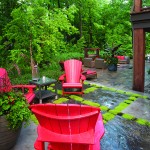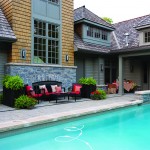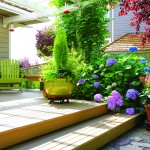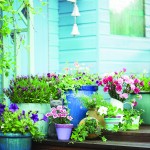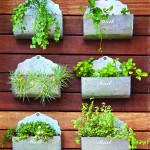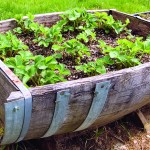Bright ideas for colourful planters
story by Judy Ross
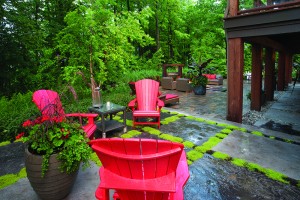
- 111 Timberleif
Scattered throughout Charlotte Vorstermans’ half-acre garden are 16 different containers all brimming with bold punches of colour. They look like vibrant floating islands. Vorstermans loves planting in containers because it is “the best way to add bright accents in the garden from spring until fall.”
Although she has gardened since childhood, Vostermans became a Master Gardener in 2009 and her Creemore garden, an ongoing labour of love, has been featured on countless garden tours. The garden itself is divided into “rooms,” where perennials, vegetables and herbs all flourish in artfully divided sections. But it’s the containers that provide most of the colour.
Container Choices
Choosing the right kind of pot to hold the plants is critical to success in container gardening. And, from a design perspective, the container should complement your home style. A pair of rustic oak barrel planters, for instance, will not suit the front entrance of a sleek, contemporary house.
More material choices are available than ever before, so here are some container types to consider:
Plastic – The most inexpensive option, plastic pots are lightweight, which is great for balconies where weight is a consideration, but not suitable for windy locations. Available in many shapes and sizes, they can be spray painted and grouped together for a consistent look. However, plastic doesn’t last; it dries out quickly and degrades when exposed to sun.
Terracotta – This is a classic choice, and the earthy colour complements most plant materials. Relatively heavy, terracotta pots won’t topple over in the wind but they will freeze and crack if left out in winter.
Glazed Ceramic – Planters made from this material come in a range of colours, shapes and sizes. These look great when clustered in groups of one colour. They retain moisture better than unglazed ceramic but will also crack in winter.
Wood – Wooden planters look natural and can be custom built as window boxes or deck planters. They will require another container to put inside and prevent timber rotting. (Charlotte Vostermans’ husband built wooden boxes specifically to hold blue plastic recycling boxes as inserts.) Wood planters can be left to weather naturally if made of cedar, or can be stained or painted. They are good for large-scale container gardening where many plant varieties are used.
Metal – Classic cast iron containers are elegant, especially flanking a formal doorway. They will last forever, but are heavy and expensive. Other metal containers like galvanized washtubs and pails must have holes drilled in the bottom. For Elaine Kettlewell of Kettlewells, the fun is in finding salvaged containers (old wagons, wheelbarrows and milk crates) and using them as planters. Come spring, her store on Hwy. 124 near Poplar Sideroad will be brimming with planted containers for sale.
Composite – These newer style planters are made from blends of material, some of them resembling wood or concrete. Virtually maintenance-free, they are guaranteed to last for years. “I like to use the heavy-duty plastic composite planters,” says Teresa Matamoros of Garden Holistics, who designs and plants dozens of containers for clients every year. “They will withstand winter and can be used year after year so they end up paying for themselves.”
Hanging & Wall-mounted Baskets – These come in different materials, but the best looking ones are not in plastic containers but have a framework of plastic-coated wire with natural liners made of coconut fibre or sphagnum moss. They blend naturally with the plant material to create a dazzling clump of colour.
Planting Know-How
If you reuse old – or even just last year’s – pots, clean them with an environmentally friendly all-purpose cleaner. Then rinse and dry before planting.
Buy a good potting soil such as triple mix. Garden soil contains too much clay and is too heavy, so never use earth from your garden; it will hold the moisture and drown the roots. Soil can get expensive and Elaine Kettlewell says, “it’s easy and much cheaper to mix your own potting soil. Just use equal amounts of pre-sterilized garden soil, sphagnum moss, and perlite or vermiculite.”
If you have large containers, fill the lower third of the pot with sand, or, as many gardeners do, simply invert a plastic pot in the bottom of the container and fill soil in and around it. Make sure the base has proper drainage. If the holes are too large, use a piece of plastic window screening to cover them.
Assess how much sun the planter will get before choosing plant material. You can use a sun calculator, or simply observe and record the number of sun hours wherever you plan to put planters. Carefully read the plant tags at nurseries; they give you all the information you need. Placing containers in a sunny spot will give you more choice of bright-coloured plant material.
You can mix annuals and perennials in planters. If you use perennials, they can be replanted in the garden at the end of the season. And remember, all plants in the same pot must share the same need for sun and shade, water and food.
Go to a good local nursery and pay attention to sections for shade and sun. You can ask for help in choosing a healthy specimen, or find out when the plants are delivered and buy on that day. One advantage of containers is that they can be moved if they’re not thriving in their original location.
Fertilizing is essential for container plants. Charlotte Vorstermans recommends using a slow release fertilizer in pellet form. Before putting in her plants in the spring, she likes to put the fertilizer in the soil, give it a thorough watering and leave for two or three days to let the soil settle. Usually this fertilizer will last from spring planting until the end of July, at which point she will start giving weekly (or more) doses of liquid fertilizer.
Designing Your Container
Nothing looks worse than a large container with a few sparse, short plants. “I don’t like to see any soil,” says Teresa Matamoros, who stuffs containers as full as possible, “and I think texture is really important. I use a combination of big leaves and smaller spiky leaves.”
For colour combinations, try taking a photo of a favourite painting – a Van Gogh with blues, purples and yellows, for instance – and replicate the colours with plant material.
Proportions are important. In gardener-speak this is called “thrillers, fillers and spillers.” Get plants for the middle of the container that are tall, upright and striking (thrillers), surround them with shorter varieties (fillers) and then put trailing plants (spillers) close to the edge so they’ll fall down the sides.
Container plants need warmth and sun, which is why the best results come from bright, sunny locations. If you have total shade, choose plants that are white or bright with golden or chartreuse leaves to give the illusion of light.
Watering
One advantage of shade is that containers don’t need as much water. Sometimes they can be left to survive on Mother Nature’s doses of rain and dew. However, “most people don’t water containers enough,” warns Charlotte Vostermans, who has spigots and watering cans placed throughout her garden so she can keep on top of the watering requirements. A general rule of thumb is to water until the water starts running out of the drainage holes in the bottom. New self-watering containers are a good choice if you can’t be around to attend to the watering yourself.
Gardeners’ Favourites
What gardeners love about containers is the ability to change the look from season to season and year to year. So many varieties will work together in a container. You can even put a trellis in the centre and grow cherry tomatoes surrounded by basil, rosemary and trailing vines. Herbs, vegetables and flowers will all co-exist happily.
“If I want to make a big statement I have a favourite combination; I plant a four-foot-tall Limelight hydrangea tree in the centre, surround it with (white-edged) Francee hostas and have white Scaevola trailing around the edges,” offers Elaine Kettlewell. “Then I place a solar light in the planter so it glows at night. At the end of summer I plant the tree in the garden, cut back the hostas and replant them as well. The only discard is the Scaevola. In the spring I’ll divide the hostas and re-use them.”
With all this new inspiration, you’ll be ready to start planning your colourful containers! Just don’t forget the old rule … wait until after May 24th to leave containers outside. Many a beautiful planter has been ruined by a late spring frost. ❧






